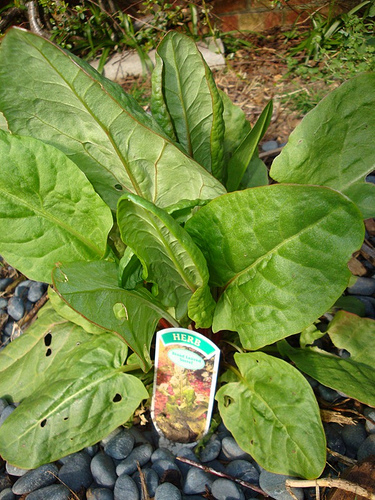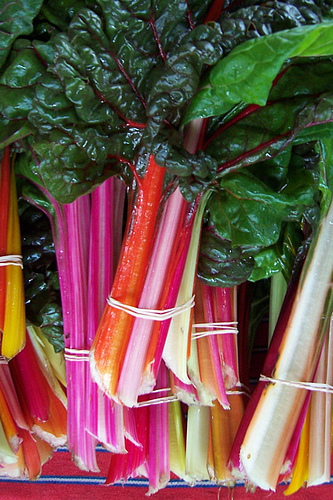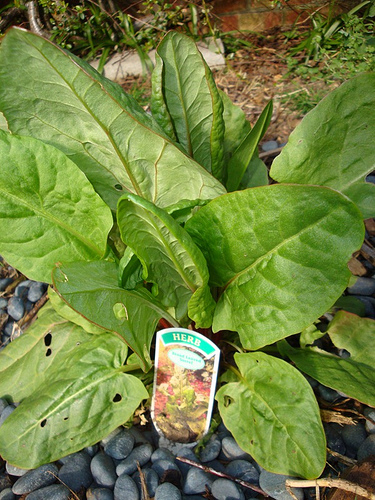 Leaves of sassbeckyannisonGardeners and gastronomes fawn over sorrel — and almost everyone else ignores it. That’s a shame. An early-spring green with brash lemony flavor that comes from an abundance of oxalic acid, sorrel is a powerful addition to soups and sauces, and tasty in salads when picked young.
Leaves of sassbeckyannisonGardeners and gastronomes fawn over sorrel — and almost everyone else ignores it. That’s a shame. An early-spring green with brash lemony flavor that comes from an abundance of oxalic acid, sorrel is a powerful addition to soups and sauces, and tasty in salads when picked young.
The herb is classified in the genus Rumex, and its origins lie somewhere in what is now Russia, where the Ural Mountains divide Asia from Europe. It was well known in Roman times, though not cultivated since it was plentiful in the wild. Culinary historians find it falling in and out of favor throughout Europe in the Middle Ages, and it seemed to do a curious dance over the English Channel as at times the French preferred it, then the English more so, then back again. It was popular in the court of King Henry VIII, then all but eradicated from the British Isles by the late 1800s when it had danced over to the US.
Still by the middle of the 20th century and even today most of the time, if you want sorrel in America you have to grow it yourself. Thankfully, very few things are easier to cultivate. It loves this bizarre spring we’ve had here in Iowa, with cool sunny days alternating with lots of rain. And it’s a perennial, so once you have it, it’s there to stay. It has no pest problems since that oxalic acid is a great natural defense, and the yield is quite high because you can keep clipping it all spring, and harvest again in the fall. A single sorrel planting can yield well for eight or ten years before needing to be replanted.
If you’d like to grow some at home, plant sorrel seed in early spring (it’s almost too late already, but not quite) in compost-enriched soil about a half-inch deep and six inches apart. When the plants are seven or eight inches high, thin them to 12 inches apart, and make sure they stay well watered. As they grow, cut the leaves for use and wait for what seems like just a minute before the new leaves jump back up. Later in the summer, you’ll see the buds of rust-red flowers begin to appear. Pinch these off unless you want more seed, else you’ll see little yield in the fall.
After three or four years, dig up the plants and split them at the root. Give a few to your friends and plant the rest in another sunny, fertile part of the garden for a few more years. It’s that easy.
In the kitchen, sorrel matches its ease of cultivation with simple versatility. The young leaves add a potent zing to baby green-salads. As they get older, they leaves are popular in fish dishes, classically shad or pike. Anything that likes lemon will like sorrel, so veal, chicken and pork dishes can benefit from it as well. Perhaps the most popular use is this eye-opening chilled sorrel soup, perfect for your first lunch on the patio:
Chilled Sorrel Soup
2 cups (packed) sorrel leaves, stemmed
2 shallots, peeled
2 cups cold chicken stock (vegetable may be substituted)
8 ounces crème fraîche (sour cream can substitute)
1/3 cup heavy cream
Salt and white pepper to taste
Fresh tarragon or mint (for garnish)
In a blender or food processor, chop the sorrel and shallot to a fine puree. Gradually add the stock and continue to blend, stopping occasionally to scrape down the sides of the bowl, until all the stock is mixed in.
Add the crème fraîche and the cream and pulse lightly until just incorporated. Season to taste with salt and pepper, then chill one hour to overnight. Serve very cold garnished with tarragon or mint. If desired you could also add more crème fraîche, some croutons, even an ice cube.




